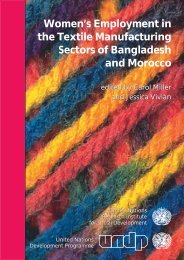Beyond Pragmatism: Appraising UN-Business Partnerships
Beyond Pragmatism: Appraising UN-Business Partnerships
Beyond Pragmatism: Appraising UN-Business Partnerships
You also want an ePaper? Increase the reach of your titles
YUMPU automatically turns print PDFs into web optimized ePapers that Google loves.
<strong>UN</strong>RISD PROGRAMME ON MARKETS, BUSINESS AND REGULATION<br />
PAPER NUMBER 1<br />
The World Bank’s evaluation of the global health programmes in which it is involved has also<br />
drawn attention to similar concerns. For example, for several of the global initiatives, the lack of<br />
continued grant aid commitment on an assured, predictable and long-term basis is a clear<br />
problem, as is the timely supply of quality, affordable drugs and an appropriate diagnostic and<br />
treatment regime. In connection with <strong>UN</strong>AIDS, the report noted that “While considerable<br />
progress has been achieved through advocacy, global programs in communicable diseases also<br />
underscore that the weakest links are the health system and financial capacities of developing<br />
countries to sustain the programs, particularly in the poorest countries” (Lele et al. 2004:xix, xx).<br />
These strong qualifications regarding the effectiveness and implications of some of the newest<br />
global health partnerships pose the question whether the increased involvement of the private<br />
sector on present lines was the most fruitful way toward achieving WHO’s goal of Health for<br />
All, of rebuilding healthcare systems, and advancing a coherent and properly funded global<br />
health system. 55<br />
The findings above suggest that in establishing global public-private health partnerships in<br />
recent years, little heed has been given to wider development experiences and debates, as well<br />
the lessons from past development strategies. Parallels have been drawn, for example, between<br />
global health partnerships such as the Global Fund to Fight AIDS, Tuberculosis and Malaria<br />
(GFATM) and the integrated rural development approach of the 1970s. The latter was the<br />
supposed panacea for broad rural development that has long since been abandoned. Like such<br />
schemes, some health partnerships continue to reflect the organizational preferences of the<br />
main donors rather than the institutional needs of partner states. Country ownership and local<br />
decision making remain tenuous, and partnership projects run parallel to existing health<br />
systems, diverting scarce human resources to the global partnership schemes. In sum, such<br />
partnerships have significant, though largely unintended, system-wide effects (Mkandawire<br />
forthcoming).<br />
Seeing the bigger picture<br />
There is a danger that impact assessment will become the new mantra in policy circles and that<br />
an impact assessment industry, akin to that associated with corporate sustainability reporting<br />
and CSR monitoring, will develop. Just as there are concerns about the substantive value of<br />
these CSR tools (Utting 2005b, Financial Times 2006), similar concerns arise in relation to impact<br />
assessment. Part of the problem relates to the methodologies used. Whether or not the ex-ante<br />
or ex-post assessment tools achieve their analytical objectives will depend partly on the<br />
questions asked, which in turn relate to the conceptual frameworks that shape the<br />
understanding of development. Focusing mainly on the contribution of partnerships to the<br />
achievement of the MDGs, for example, will not necessarily say much about either the<br />
sustainability of partnerships or economic and social sustainability.<br />
OECD (2006:12–13) lists some of the most prominent assessment frameworks and<br />
methodologies for evaluating partnerships and points to the fact that “most focus largely on<br />
procedural aspects of partnerships. Not all examine the impact of partnerships and fewer still<br />
look at the efficiency aspects”. However, other dimensions may also need to be considered to<br />
assess key contributions, contradictions and trade-offs associated with inclusive and equitable<br />
development, as the following study makes clear.<br />
An evaluation of a PPP in the tannery industry in Pakistan, which involves <strong>UN</strong>IDO and <strong>UN</strong>DP,<br />
identifies various limitations regarding the use of “classical effect” evaluation methods, such as<br />
those advocated by the OECD for evaluating aid interventions (Lund-Thomsen 2006). These<br />
focus on criteria associated with relevance, effectiveness, efficiency, impact and sustainability.<br />
Such methods need to be complemented by others. These include both “realist” approaches,<br />
which emphasize the importance of theory and context in explaining the dynamics and<br />
55<br />
Beigbeder 2004; Buse and Walt 2000; Richter 2004b.<br />
24
















